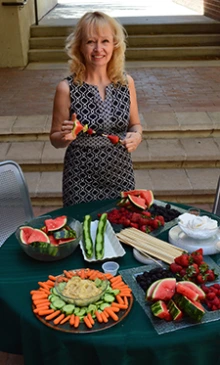Use Mindful Eating to Change Your Relationship with Food
Everywhere we turn, there’s another diet, pill or cleanse promising to help us lose weight—fast.

Everywhere we turn, there’s another diet, pill or cleanse promising to help us lose weight—fast. But these quick-fix solutions don’t promote permanent change.
"Going on a diet infers that you will go off the diet," says Dr. Patti Daly, clinical assistant professor at the University of Arizona College of Nursing. "It's a temporary measure to control your weight, whether it's to look good for your cousin's wedding, your upcoming family reunion or some other milestone."
The root of our problem with food is not food itself, but our relationship with it, according to Dr. Daly. By the time we're adults, most of us have learned to eat for a variety of reasons that have nothing to do with physical hunger.
Common triggers to eat include:
- Eye hunger: seeing something we want to eat (why seeing the dessert tray tempts us to order even though we're stuffed)
- Nose hunger: smelling something we want to eat (why we crave cinnamon rolls when we pass through the mall food court)
- Mouth hunger: eating repetitively, usually something crunchy or creamy (why we eat a whole bag of chips in one sitting)
- Heart hunger: eating because we're bored, tired, lonely or sad (snacking mindlessly while we watch TV)
- Mental hunger: checking the clock, realizing we skipped lunch hours ago and then eating (deciding we should be hungry)

Dr. Patti Daly with the UA College of Nursing conducts research and teaches about mindful eating.
But what exactly does mindful eating look like?
Let's say you love chocolate chip cookies. The problem is not the cookie itself (in fact, making it forbidden may cause cravings). The real problem is devouring a bag of cookies without paying full attention to what you're doing, such as while driving, reading or watching a movie.
Instead, slow down, be mindful and enjoy the experience:
- Put the cookie on a nice plate. Please your eye hunger by looking at it and enjoying how delicious it looks.
- Indulge your nose hunger by enjoying the aroma of the cookie.
- Break the cookie into little pieces. Put one in your mouth and stop. Close your eyes. Use your mouth hunger to appreciate the texture and the flavor of the cookie.
When Dr. Daly teaches mindful eating, she uses a variety of techniques to help people change their relationship with food. You can try some at home:

Eating while distracted is one of the ways we practice unhealthy eating habits.
- Change the cadence of your eating. Put your utensils down between bites, or try swapping chopsticks for silverware (or vice versa).
- Don’t eat when distracted. Turn off the TV, and don’t eat in the car.
- Downsize your portions. Most people "clean their plate," regardless of the amount. If you're dining out with someone, split an entrée (you can always order more, later). If you're alone, ask the server to box up half your meal to go before bringing it to the table.
- Be aware of eye hunger. Keep less healthy food out of sight. If someone gives you a cake, eat a slice and freeze the rest. Don’t leave it on the counter in plain view.
- Plan in advance for snacking and meals. Keep fresh fruit and vegetables washed, chopped and ready to eat so you're not tempted to reach for something else. If you always eat something crunchy while sitting at the computer, swap out your chips for carrots or celery sticks.
For those interested in practicing mindful eating, Dr. Daly has some simple yet surprising advice.
"Conjure up your inner 2-year-old, who only eats when they’re truly hungry: become someone who will shake their head 'NO,' clamp their mouth closed and refuse to eat what's left on the plate in front of them because they are full."
About the Author
The University of Arizona College of Nursing is leading through innovative learning, established in 1957. As a top school in the country for strengthening the nursing workforce, we educate entry and advanced practice nurse leaders to deliver comprehensive, coordinated and compassionate health care; shape health policy for individuals, families, communities and care systems; and advance nursing science through innovative research, technology and collaboration.

